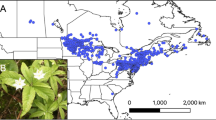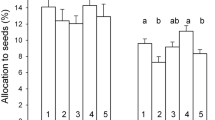Abstract
The objective of this study is to determine the height and age at which reproduction begins (i.e., production of flowers and fruits; the transition to adulthood) in the giant saguaro cactus (Carnegiea gigantea) in four geographically and environmentally distinct populations, and to relate observed variability to environmental differences. The onset of reproduction has been estimated at a height of 2.2 m in near optimal conditions. This value has been widely accepted and applied to populations in less optimal conditions, although variations under less ideal conditions have not been investigated. In addition, previous research has demonstrated that Carnegiea growth rates are highly variable over their range. Thus, even if 2.2 m is a consistent transition height to adulthood over their range, the age of individuals in different populations would be different. I investigate the age and height at which this transition occurs.
The author sampled the heights of the shortest reproductive individuals and the tallest non-reproductive individuals to estimate the mean height of the onset of flowering in each of four locales in the northern Sonoran Desert. Using a previously published age-height-growth model, the mean age of the start of reproduction was also computed for the four sites. ANOVA and t-tests were used to compare the average transition to adulthood across sites by both age and height.
Statistical results are robust and significant variations in the onset of reproduction are observed by both age and height across the four sites. Saguaro National Park and Organ Pipe Cactus National Monument individuals are transitioning to adulthood, on average, at younger ages and shorter heights than the other two locales. At the arid and marginal Kofa site, individuals that established during the regeneration peak of the late 1800s-early 1900s are only now becoming reproductive (individuals that established around 1899), while at Saguaro National Park, on average, individuals that established in the 1950s are already transitioning to adulthood. These results have implications for regeneration, particularly in marginal locales where regeneration is already limited.

Similar content being viewed by others
References
Bowers JE (1996) Environmental determinants of flowering date in the columnar cactus Carnegiea gigantea in the northern Sonoran Desert. Madroño 43:69–84
Bowers JE (2005) New evidence for persistent or transient seed banks in three Sonoran Desert cacti. Southwest Nat 50(4):482–487
Bowers JE, Pierson EA (2001) Implications of seed size for seedling survival in Carnegiea gigantea and Ferocactus wislizeni (Cactaceae). Southwest Nat 46:272–281
Brum GD (1973) Ecology of the saguaro (Carnegiea gigantea): phenology and establishment in marginal populations. Madroño 22:195–204
Drezner TD (2003a) A test of the relationship between seasonal rainfall and saguaro cacti branching patterns. Ecography 26(4):393–404
Drezner TD (2003b) Saguaro (Carnegiea gigantea, Cactaceae) age-height relationships and growth: the development of a general growth curve. Am J Bot 90(6):911–914
Drezner TD (2003c) Regional- and local-scale variations in plant distribution in the Sonoran Desert. Madroño 50(2):122–125
Drezner TD (2003d) Branch direction in Carnegiea gigantea (Cactaceae): regional patterns and the effect of nurse plants. J Veg Sci 14:907–910
Drezner TD (2004a) A comparison of saguaro regeneration on slopes and flats in Saguaro National Park and in South Mountain, Arizona. J Arizona-Nevada Acad Sci 36(2):63–67
Drezner TD (2004b) Saguaro recruitment over their American range: a separation and comparison of summer temperature and rainfall. J Arid Environ 56:509–524
Drezner TD (2005) Saguaro (Carnegiea gigantea, Cactaceae) growth rate over its American range and the link to summer precipitation. Southwest Nat 50(1):65–68
Drezner TD (2006a) Regeneration of Carnegiea gigantea (Cactaceae) since 1850 in three populations in the Northern Sonoran Desert. Acta Oecologica 29:178–186
Drezner TD (2006b) Saguaro (Carnegiea gigantea) densities and reproduction over the northern Sonoran Desert. Phys Geogr 27:505–518
Drezner TD (2006c) Plant facilitation in extreme environments: the non-random distribution of saguaro cacti (Carnegiea gigantea) under their nurse associates and the relationship to nurse architecture. J Arid Environ 65:46–61
Drezner TD, Balling RC Jr (2002) Climatic controls of saguaro (Carnegiea gigantea) regeneration: a potential link With El Niño. Phys Geogr 23(6):465–475
Drezner TD, Garrity CM (2003) Saguaro distribution under nurse plants in Arizona’s Sonoran Desert: directional and microclimate influences. Prof Geogr 55(4):505–512
Fleming TH, Sahley CT, Holland JN, Nason JD, Hamrick JL (2001) Sonoran Desert columnar cacti and the evolution of generalized pollination systems. Ecol Monogr 71(4):511–530
Johnson DS (1924) The influence of insolation on the distribution and on the developmental sequence of the flowers of the giant cactus of Arizona. Ecology 5:70–82
Medel-Narvaez A, De La Luz JLL, Freaner-Martinez F, Molina-Freaner F 2006. Patterns of abundance and population structure of Pachycereus pringlei (Cactaceae), a columnar cactus of the Sonoran Desert. Plant Ecol 187:1–14
Niering WA, Whittaker RH, Lowe CH (1963) The saguaro: a population in relation to environment. Science 142:15–23
Nobel PS (1980a) Morphology, nurse plants, and minimum apical temperatures for young Carnegiea gigantea. Bot Gaz 141:188–191
Nobel PS (1980b) Morphology, surface temperatures, and northern limits of columnar cacti in the Sonoran Desert. Ecology 61:1–7
Nobel PS (1982) Low-temperature tolerance and cold hardening of cacti. Ecology 63:1650–1656
Obeso JR (2002) The costs of reproduction in plants. New Phytol 155:321–348
Parker KC (1993) Climatic effects on regeneration trends for two columnar cacti in the northern Sonoran Desert. Ann Assoc Am Geogr 83:452–474
Pierson EA, Turner RM (1998) An 85-year study of saguaro (Carnegiea gigantea) demography. Ecology 79:2676–2693
Rice WR (1989) Analyzing tables of statistical tests. Evolution 43:223–225
Schmidt JO, Buchmann SL (1986) Floral biology of the saguaro (Cereus giganteus) I: pollen harvest by Apis mellifera. Oecologia 69:491–498
Shreve F (1931) Fouquieriaceae, Larrea tridentata, Carnegiea gigantea. Die Pflanzenareale 3(1):4–6
Steenbergh WF, Lowe CH (1976) Ecology of the saguaro I: the role of freezing weather in a warm-desert plant population. In: Research in the Parks. National Park Service Symposium Series No. 1. Washington DC, National Park Service, pp 49–92
Steenbergh WF, Lowe CH (1977) Ecology of the saguaro II: reproduction, germination, establishment, growth, and survival of the young plant. National Park Service Scientific Monograph Series No. 8. National Park Service
Steenbergh WF, Lowe CH (1983) Ecology of the saguaro III: growth and demography. National Park Service Scientific Monograph Series No. 17. National Park Service
Turner RM (1990) Long-term vegetation change at a fully protected Sonoran Desert site. Ecology 71:464–477
Turner RM, Alcorn SM, Olin G, Booth JA (1966) The influence of shade, soil, and water on saguaro seedling establishment. Bot Gaz 127:95–102
Turner RM, Bowers JE, Burgess TL (1995) Sonoran Desert plants: an ecological atlas. Univ. of Arizona Press
Yeaton RI, Karban R, Wagner HB (1980) Morphological growth patterns of saguaro (Carnegiea gigantea: Cactaceae) on flats and slopes in Organ Pipe Cactus National Monument, Arizona. Southwest Nat 25:339–349
Acknowledgements
I thank Barbara Trapido-Lurie for help with the creation of the map.
Author information
Authors and Affiliations
Corresponding author
Rights and permissions
About this article
Cite this article
Drezner, T.D. Variation in age and height of onset of reproduction in the saguaro cactus (Carnegiea gigantea) in the Sonoran Desert. Plant Ecol 194, 223–229 (2008). https://doi.org/10.1007/s11258-007-9286-9
Received:
Accepted:
Published:
Issue Date:
DOI: https://doi.org/10.1007/s11258-007-9286-9




